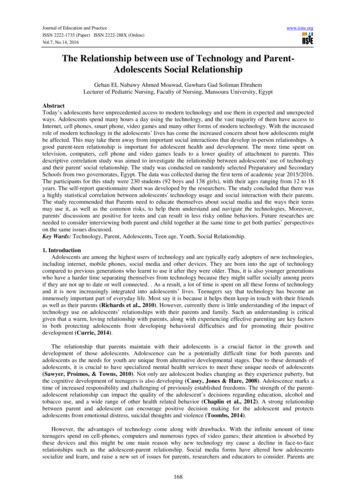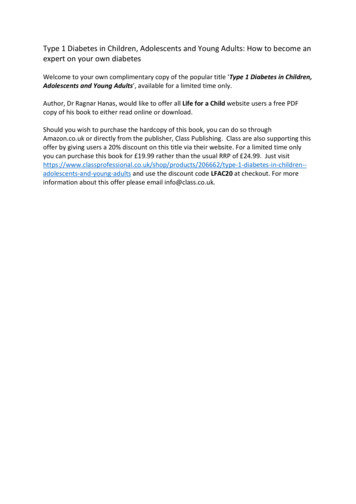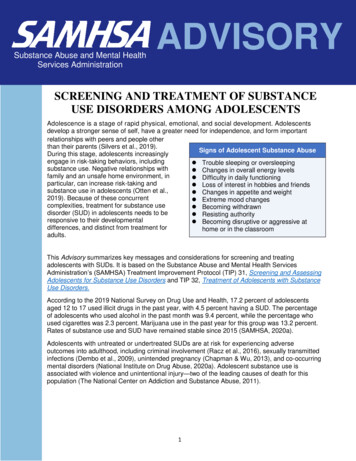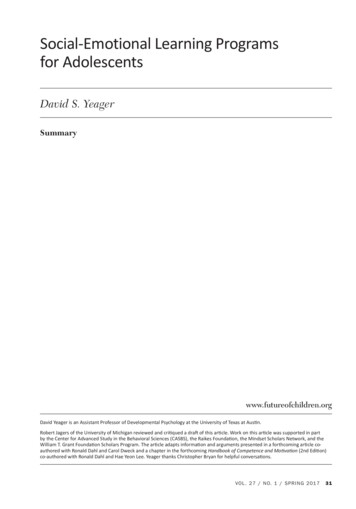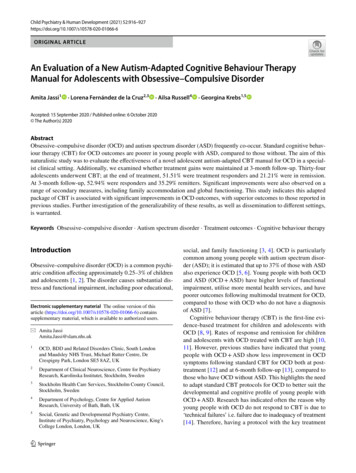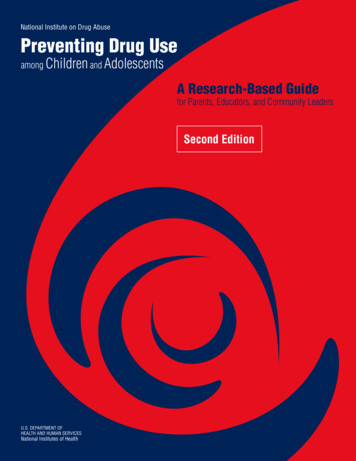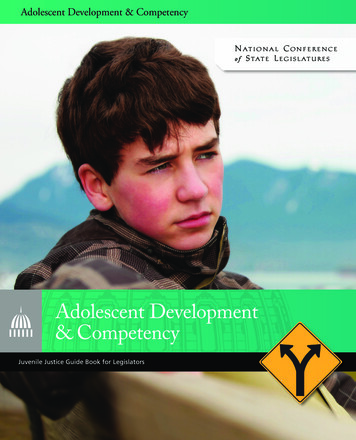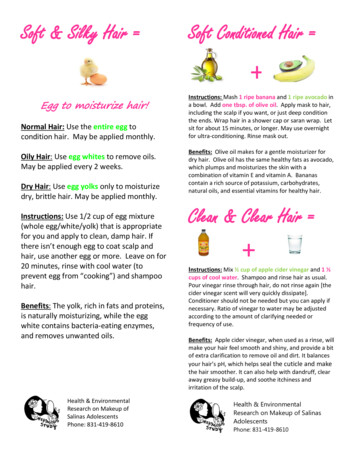
Transcription
Humensky Substance Abuse Treatment, Prevention, and Policy 2010, 1/19RESEARCHOpen AccessAre adolescents with high socioeconomic statusmore likely to engage in alcohol and illicit druguse in early adulthood?Jennifer L HumenskyAbstractBackground: Previous literature has shown a divergence by age in the relationship between socioeconomic status(SES) and substance use: adolescents with low SES are more likely to engage in substance use, as are adults withhigh SES. However, there is growing evidence that adolescents with high SES are also at high risk for substanceabuse. The objective of this study is to examine this relationship longitudinally, that is, whether wealthieradolescents are more likely than those with lower SES to engage in substance use in early adulthood.Methods: The study analyzed data from the National Longitudinal Survey of Adolescent Health (AddHealth), alongitudinal, nationally-representative survey of secondary school students in the United States. Logistic regressionmodels were analyzed examining the relationship between adolescent SES (measured by parental education andincome) and substance use in adulthood, controlling for substance use in adolescence and other covariates.Results: Higher parental education is associated with higher rates of binge drinking, marijuana and cocaine use inearly adulthood. Higher parental income is associated with higher rates of binge drinking and marijuana use. Nostatistically significant results are found for crystal methamphetamine or other drug use. Results are not sensitive tothe inclusion of college attendance by young adulthood as a sensitivity analysis. However, when stratifying by race,results are consistent for white non-Hispanics, but no statistically significant results are found for non-whites. Thismay be a reflection of the smaller sample size of non-whites, but may also reflect that these trends are drivenprimarily by white non-Hispanics.Conclusions: Previous research shows numerous problems associated with substance use in young adults,including problems in school, decreased employment, increases in convictions of driving under the influence (DUI)and accidental deaths. Much of the previous literature is focused on lower SES populations. Therefore, it is possiblethat teachers, parents and school administrators in wealthier schools may not perceive as great to addresssubstance abuse treatment in their schools. This study can inform teachers, parents, school administrators andprogram officials of the need for addressing drug abuse prevention activities to this population of students.BackgroundThe relationship between childhood socioeconomic status (SES) and behavioral health in adulthood has longbeen of interest to researchers and policymakers. A fewstudies have found that adolescents with low SES have agreater propensity toward substance use during adolescence. Goodman and Huang [1], studying the first waveof AddHealth data cross-sectionally, found that havingCorrespondence: jhumensk@uchicago.eduEdward Hines Jr VA Hospital, Center for Management of Complex ChronicCare, 5000 S. Fifth Avenue (151H), Bldg 1, B251, Hines, IL 60141, USAFull list of author information is available at the end of the articlelow SES was associated with greater alcohol use andwith greater cigarette and cocaine use among whiteteenagers. Goodman and colleagues [2] found that lowerhousehold income and parental education were associated with greater adolescent depression. Friestad andcolleagues [3] found that low parental education andmoderate household income was associated with greaterrates of smoking in adolescents. Reinherz and colleagues[4], examining 360 respondents followed from 19772000, found that low family SES and larger family sizewere associated with increased probability of substanceabuse disorders in early adulthood. An analysis by 2010 Humensky; licensee BioMed Central Ltd. This is an Open Access article distributed under the terms of the Creative CommonsAttribution License (http://creativecommons.org/licenses/by/2.0), which permits unrestricted use, distribution, and reproduction inany medium, provided the original work is properly cited.
Humensky Substance Abuse Treatment, Prevention, and Policy 2010, 1/19Hamilton and colleagues [5], of the Ontario StudentDrug Use Survey, found that adolescents (ages 12-19)with college-educated parents were less likely to engagein hazardous or harmful drinking or illicit drug use.However, there is growing evidence that adolescentswith higher SES may also be at risk for developing substance use disorders. There is evidence that substanceuse in adults, particularly alcohol use, may be sensitiveto price, as some studies have shown that consumptiondecreases as price increases [6-9]. For adolescents withhigher SES, having greater financial resources may indicate that the relative cost of substance use, that is theopportunity cost of substance use relative to other consumption, may be lower than for adolescents with lowerSES. This is consistent with the usual demand model forgoods and services, and could indicate a higher demandamong wealthier adolescents. This was found in a 2007study of British adolescents by Bellis and colleagues,which found that adolescents with more spendingmoney were more likely to drink frequently, binge drinkand to drink in public [10], as well as in a study of college students in the United States, which found that college students with lower levels of spending money hadlower levels of drinking and getting drunk [11],Engagement in substance use can have negative implications for young adults. Previous research has shownthat substance use at young ages is associated withdecreased educational attainment [12,13] and labor market productivity [14,15]. Binge drinking in particular hasbeen linked to driving under the influence of alcohol(DUI) and accidental deaths in college-age students [16].As illicit drugs are illegal in the United States, the useof these substances places young adults at risk of involvement in the criminal justice system. Thus, substanceuse can have substantial negative consequences foryoung adults. However, as much previous literature hasfocused on the substance use of lower income adolescents [1-5], it is possible that parents, teachers, policymakers and program administrators may be less focusedon the possible long-term implications of substance useon adolescents with higher SES [17-19].The purpose of this study is to examine whether adolescents with high SES, as measured by parental education and income, are more likely to engage in alcoholand illicit drug use in early adulthood, using a prospective, nationally-representative sample of secondaryschool students in the United States. This expands uponthe work of Bellis and colleagues [10], who examinedcross-sectional data on alcoholism in the United Kingdom and Martin and colleagues [11], who examinedprevalence of alcohol use among college students in theUnited States. As much of the previous literature hasfocused on adolescents with lower SES, the findings ofthis study could help parents, teachers and practitionersPage 2 of 10to identify students who may be at risk for future substance use and educational problems.MethodsDataThe data comes from the National Longitudinal Surveyof Adolescent Health (AddHealth). The first wave ofAddHealth was conducted in 1994-1995, and consistedof a nationally representative sample of school studentsin grades 7-12 in the United States. The sample was aschool-based cluster design, which was selected toensure a nationally representative population, by region,urbanicity, racial and ethnic composition, school type,and school size [20].A total of 20,745 students completed the in-homeinterview. Parents of students who were selected for thein-home interview were also interviewed. The thirdwave of the study, which followed-up respondents fromthe Wave I interview, was completed in 2001-02, whenrespondents were 18-27 years old. A few respondents(72 students) with mental retardation were excludedfrom the sample, as their educational trajectories arelikely to differ from those of their peers.Estimation ModelsThe estimation models examine the relationship betweenadolescent SES and subsequent use of alcohol and illicitdrugs, controlling for baseline use of alcohol and illicitdrugs and mental health (depressive symptoms, delinquency and suicidality) and a set of other individual,family school and neighborhood characteristics.The outcome variables of interest are binge drinkingand illicit drug use in early adulthood. AddHealth asksrespondents separately about their use of alcohol, marijuana, cocaine, crystal methamphetamine and any otherdrug use. As the use of these substances is measuredseparately in AddHealth, they are analyzed separately inthese analyses. Substance use was measured as a binaryindicator of use, as previous research has found thatresponders tend to report accurately whether they consume substances, but tend to under-report the amountconsumed [6]. Sensitivity analyses found that resultswere qualitatively similar when examining a continuousmeasure of use (not shown).The key independent variable was socioeconomic statusat baseline, as measured by parental education andincome. As these were assessed separately in AddHealth,they are analyzed separately in these analyses as well. Theparents’ socioeconomic status reflects the economic statusof the family in which the adolescent resides at baseline.Previous research has shown that parental socioeconomicstatus reflects the child’s socioeconomic status [21]. Thehighest educated parent was used rather than the education level of the mother and father to avoid losing
Humensky Substance Abuse Treatment, Prevention, and Policy 2010, 1/19respondents living in single parent families [22]. Household income was also included as a separate measure ofSES, as household income captures smaller gradations infamily well-being than parental income [23].A number of the adolescent’s baseline personal characteristics were also included in the model. The adolescent’s baseline binge drinking and illicit drug use wasincluded in the model in order that these models measure change in substance use from baseline to follow-upin early adulthood. In addition, other behavioral healthfactors at baseline were controlled for, including delinquency, suicidality and depressive symptoms, due to thehigh rates of comorbidity of mental health diagnosesamong persons with substance abuse [24].A number of demographic variables were alsoincluded in the model, including age, gender, and race/ethnicity. Additional individual characteristics that havebeen shown to be correlated with educational attainment were included, such the Peabody Picture Vocabulary (PPVT) score, which measures cognitive ability [25],and general health, which measures physical health andmay account for endogeneity between mental health andlabor market outcomes [26,27].A number of family background variables were alsoincluded in the model. An indicator of whether therespondent was the first child born in the family wasincluded, as previous research has shown that childrenborn first in the family tend to have better educationaloutcomes [28]. Family structure (single parent household,stepfamily and foster/other) is included, as children fromnon-traditional families often face barriers to schooling[29]. An indicator for whether the respondent’s biologicalmother and father have alcoholism is included as alcoholism has a high genetic component [30].The estimation model is of the form:Logit ( p i ,t 1 ) 00 01SES i 02BH i 03X i iWhere:p i,t 1 Probability of substance use at Wave III, asmeasured by binge drinking, marijuana use, cocaine use,crystal methamphetamine use and other drug use, estimated separately. Binge drinking was measured as a binary variable with a positive value indicating 5 or moredrinks in one setting more than once a month in thepast year. Marijuana, cocaine, crystal methamphetamineand other drug use was measured as a binary variablewith a positive value indicating any use in the past 30days.SESi Socioeconomic status at baseline, as measuredby parental education and household income. Parentaleducation was measured by the education level of thehighest educated parent living with the adolescent, andwas categorized by the highest educated parent havingPage 3 of 10not completed high school, having completed highschool only, having education beyond high school butless than a college degree, or having a college degree.Household income was measured continuously and wastopcoded in AddHealth at 999,000, so reported incomeranged from 0- 999,000.BHi A number of behavioral health (mental healthand substance use) characteristics at baseline in adolescence (Wave I interview) were included in the model:binge drinking, marijuana, cocaine, inhalant and otherdrug use at baseline, as well as depressive symptoms,delinquency and suicidality. Each of these componentswas included separately in the model. As with the outcome variables, binge drinking in adolescence was measured as a binary variable with a positive valueindicating 5 or more drinks in one setting more thanonce a month in the past year. Marijuana, cocaine, inhalant and other drug use was measured as a binary variable with a positive value indicating any use of thesesubstances in the past 30 days. Depressive symptoms aremeasured by the Center for Epidemiologic StudiesDepression scale (CES-D) [31,32]. Delinquency is a scaleof 0-12 of criminal behaviors in the past year [33]. Suicidality is measured by a binary variable with a positivevalue indicating a suicide attempt in the past year.Xi A number of individual and family characteristicsincluded as control variables. These include demographic variables such as gender, age, age squared(to account for non-linearities in age), and race/ethnicity[34]. Race/ethnicity categories are defined as Hispanicor white non-Hispanic, black non-Hispanic, Asian nonHispanic, or other race, non-Hispanic. The Peabody Picture vocabulary test score is measured on a continuousscale, and is standardized so that the mean is approximately 100. General health is categorized as excellent,very good, good, or fair/poor. Family structure is categorized as two biological parents, single parent household, stepfamily or foster/other family. A binaryindicator indicates whether the adolescent is the firstborn in the family, and whether the adolescent has abiological mother or father with alcoholism.These equations were analyzed using Stata 10.0. Logitmodels were analyzed because the outcome variables ofinterest were dichotomized, and odds ratios are reportedin the tables. The research protocol was approved bythe University of Chicago Social and Behavioral SciencesInstitutional Review Board (#H06238).Missing ObservationsA total of 20,745 students completed the AddHealth inhome interview, and of these, 15,170 followed up atWave III. There is thus attrition as well as item nonresponse. Item non-response is particularly problematicfor the items asked of parents, parental income and
Humensky Substance Abuse Treatment, Prevention, and Policy 2010, 1/19alcoholism. The final sample, with no missing observations, was 9,872. Therefore, sample loss is a concern.This was addressed using re-weighting and imputationmeasures. Results were qualitatively similar under reweighting and imputation, and so the results presentedhere use the AddHealth’s weights and original sample toallow for greater replicability. The full detail is providedin Additional file 1.ResultsDescriptive StatisticsTable 1 shows descriptive statistics. In adolescence, theaverage household income was about 46,000 at thetime of baseline data collection (1994-1995). In about 9percent of households, the highest educated residentparent did not complete high school. In about 34 percent of households, the highest educated resident parenthad a college education.About 25 percent engaged in binge drinking in earlyadulthood (Wave III), about 24 percent engaged in marijuana use, about 4 percent engaged in cocaine use, onepercent in crystal methamphetamine use, and about 5percent in other drug use.Regression ResultsTable 2 shows the regression results examining theassociation between SES in adolescence and subsequentsubstance use in early adulthood. Higher parental education is associated with higher odds of binge drinking,marijuana use and cocaine use. For an individual with acollege-educated parent, the odds of binge drinking inearly adulthood are 1.458 times as large as the odds foran individual with a high school-educated parent onceall controls are included in the model (AOR 1.458,95% CI [1.190-1.788]). Likewise, for an individual with acollege-educated parent, the odds of engaging in marijuana use in early adulthood are 1.265 times as large asthe odds for an individual with a high school-educatedparent (AOR 1.265, 95% CI [1.038-1.541]). The oddsof engaging in cocaine use in early adulthood are 1.614times as large for an individual with a college-educatedparent versus a high school-educated parent (AOR 1.614, 95% CI [1.088-2.395]). No statistically significanteffects are found for crystal methamphetamine andother drug use.Table 3 shows the regression results examining theassociation between SES as measured by householdincome in adolescence and substance use in early adulthood. Higher household income is associated withhigher probability of binge drinking and marijuana use.An additional 1000 in annual household income inadolescence is associated with an increase of 1.003 inthe odds of binge drinking in early adulthood (AOR 1.003, 95% CI [1.001-1.004]). It should be noted thatPage 4 of 10this result, while statistically significant, is quite small.Likewise, an additional 1000 in annual income in adolescence is associated with an increase of 1.002 in theodds of marijuana use in early adulthood (AOR 1.002,95% CI [1.000-1.003]), and an increase of 1.002 in theodds of cocaine use, though the results for cocaine uselose statistical significance once controls are addedto the model (OR 1.002, 95% CI [1.000-1.004], AOR 1.002, 95% CI [0.999-1.004]). No statistically significantresults are found for crystal methamphetamine or otherdrug use.Sensitivity AnalysesTables 4 and 5 show sensitivity analyses. Table 4 showsthe results when college attendance in young adulthood(by Wave III) is included in the model. It should benoted that the prospective nature of the model is violated in this sensitivity analysis, as an independent variable, college attendance, is measured at Wave III, as isthe outcome variable. Still, this analysis is useful inexamining whether the relationships seen in Tables 2and 3 are simply functions of college attendance. It ispossible that wealthier young adults are more likely toattend college, and thus to be living near peers who areengaging in substance use, particularly alcohol and marijuana use. College attendance by Wave III is measuredby enrollment or graduation from a two or four yearcollege at the Wave III interview.The results show that the relationships seen above arerobust to the inclusion of college attendance. Personswith higher parental education (as measured in adolescence) have a higher probability of binge drinking (jointtest p 0.01), marijuana (joint test p 0.01) and cocaineuse (joint test approaching significance at p 0.10), whencontrolling for college attendance. In addition, higherhousehold income in adolescence is associated with ahigher probability of binge drinking (AOD 1.003, 95%CI [1.000-1.004]), marijuana use (AOD 1.002, 95% CI[1.000-1.003]), and cocaine use (AOD 1.002, 95% CI[1.000-1.004]) in early adulthood when college attendance is controlled for. No statistically significant resultswere found for crystal methamphetamine or other druguse. The results of this sensitivity analysis indicate thatthe higher rates of binge drinking, marijuana and cocaineuse are not solely the result of greater college attendance.Table 5 stratifies results by race, white non-Hispanicversus non-whites. Although results for white non-Hispanics are qualitatively similar to the results in Table 2for the whole population, none of the results for thenon-whites are statistically significant. This may be afunction of the smaller sample size (n 5580 for whitesand n 4292 for non-whites). It may also be that theresults found are being driven primarily by whiteadolescents.
Humensky Substance Abuse Treatment, Prevention, and Policy 2010, 1/19Page 5 of 10Table 1 Descriptive Statistics (n 9872)VariableMeanSt. ErrorBaseline Variables, Wave IHousehold income, in 1000s, range: 0-999 (topcoded)46.071.70Highest educated resident parent has less than high school education9.40%1.05%.high school education25.82%1.14%.more than high school education31.26%0.97%.college graduate and beyond33.53%1.85%Binge Drinking, Wave IMarijuana Use, Wave I16.98%13.70%0.87%0.80%Cocaine Use, Wave I1.10%0.16%Inhalant Use, Wave I1.76%0.20%Other Drug Use, Wave I4.05%0.39%CES-D Score, Wave I11.190.16Delinquency Scale, Wave I1.590.04Suicidality, Wave I3.91%0.29%Verbal Ability (PPVT)Age at Wave I101.7115.780.570.12Male50.84%0.76%White, non-Hispanic69.02%2.74%Black, non Hispanic13.28%1.91%Hispanic10.63%1.57%Asian, non-Hispanic2.59%0.63%Other/multi race4.48%0.45%Excellent general healthVery good general health27.98%40.52%0.66%0.84%Good general health24.93%0.65%Fair/poor general health6.57%0.45%Single parent household25.40%1.09%Two biological parent her household6.56%0.40%Biological parent alcoholismFirstborn16.05%52.19%0.72%0.97%Binge Drinking24.73%1.04%Marijuana Use23.98%0.80%Cocaine Use3.69%0.30%Crystal Methamphetamine UseOther Drug Use1.46%5.34%0.18%0.38%Outcome Variables, Wave IIIDescriptive statistics are weighted, cluster and strata corrected.DiscussionThe results from this study indicate that higher SES inadolescence, as measured by parental education andhousehold income in adolescence, is associated withhigher rates of substance use, particularly binge drinking, marijuana use and cocaine use, in early adulthood.No statistically significant results were found for crystalmethamphetamine or other drug use. Results wereconsistent when controlling for college attendance byyoung adulthood as a sensitivity analysis. When stratifying by race, results were consistent for white non-Hispanics, but no significant results were found for nonwhites. This may be a function of a smaller sample sizeof the non-white sample, or it may be that the resultsare driven primarily by white non-Hispanic respondents.In addition, sensitivity analyses were performed while
Humensky Substance Abuse Treatment, Prevention, and Policy 2010, 1/19Page 6 of 10Table 2 The Relationship between Parental Education in Adolescence and Substance Use in Early Adulthood. (n 9872)Binge Drinking Marijuana Use Cocaine Use Crystal Meth. Use Other Drug UseParents’ EducationUnadjusted OR (95% CI)Highest educated resident parent less than high 17)**.High school.Some erence1.091(0.779-1.528)1.203(0.869-1.665)F(3,126) 17.63***F(3,126) 6.32***F(3,126) 2.99*F(3,126) 1.72F(3,126) .498)F(3,126) 7.72***F(3,126) 3.35*F(3,126) 2.31†F(3,126) 1.40F(3,126) 1.73.College graduateJoint testAdjusted OR (95% CI)Highest educated resident parent has less than high school 0.812(0.605-1.089).High schoolReference.Some college.College graduateJoint test of parental educationStatistical significance based on t-tests: † p .10; * p .05; ** p 0.01; *** p .001Note: Dependent variables assessed at Wave III. Independent variables assessed at Wave I. Adjusted models control for binge drinking, marijuana use, cocaineuse, inhalant use and other drug use at baseline, CESD, delinquency, suicidality, PPVT score, gender, age, age squared, race/ethnicity, general health, familystructure (two biological parents, single parent, stepfamily, foster/other), parent alcoholism and whether adolescent is firstborn in family. Logit models with dataweighted, clustered and strata corrected.Other drug use includes LSD, PCP, ecstasy, mushrooms, inhalants, ice, heroin, prescription medicine not prescribed for you or any other drug.not controlling for adolescent substance use, and resultswere qualitatively similar (not shown).Previous literature has shown that the relationshipsbetween SES and substance use vary by age. The results inthis paper are somewhat contrary to previous literature inyouth which has shown that lower SES is associated withhigher rates of substance use problems [1-5]. However, theresults of this study are consistent with previous researchin adults, which found that demand for illicit substances isprice sensitive [6-9], and thus predicts that substance usewill increase as income is higher. This therefore indicatesthat the behavior of young adults more closely reflects thatTable 3 The Relationship between Household Income in Adolescence and Substance Use in Early Adulthood. (n 9872)Binge DrinkingMarijuana UseCocaine UseCrystal Meth. UseOther Drug ld IncomeUnadjusted OR (95% CI)Income (1000s)Adjusted OR (95% CI)Income (1000s)Statistical significance based on t-tests: † p .10; * p .05; ** p 0.01; *** p .001Note: Dependent variables assessed at Wave III. Independent variables assessed at Wave I. Adjusted models control for binge drinking, marijuana use, cocaineuse, inhalant use and other drug use at baseline, CESD, delinquency, suicidality, PPVT score, gender, age, age squared, race/ethnicity, general health, familystructure (two biological parents, single parent, stepfamily, foster/other), parent alcoholism and whether adolescent is firstborn in family. Logit models with dataweighted, clustered and strata corrected.Other drug use includes LSD, PCP, ecstasy, mushrooms, inhalants, ice, heroin, prescription medicine not prescribed for you or any other drug.
Humensky Substance Abuse Treatment, Prevention, and Policy 2010, 1/19Page 7 of 10Table 4 Sensitivity Analysis: The Relationship between Parental Education and Income in Adolescence and SubstanceUse in Early Adulthood, controlling for College Attendance by Wave III (n 9872)Binge Drinking Marijuana Use Cocaine UseCrystal Meth. Use Other Drug UseParents’ EducationAdjusted OR (95% CI)Highest educated resident parent less than high school 38)0.700(0.193-2.538)0.597(0.298-1.195).High school.Some ence0.964(0.645-1.442)1.115(0.725-1.714)F(3,125) 5.44**F(3,125) 4.72**F(3,125) 2.64†F(3,125) 0.22F(3,125) 996(1.000-1.004) † (0.988-1.004).College graduateJoint testHousehold Income (1000s)Adjusted OR (95% CI)Income (1000s)1.000(0.998-1.002)Statistical significance based on t-tests: † p .10; * p .05; ** p 0.01; *** p .001Note: Dependent variables assessed at Wave III. Independent variables assessed at Wave I. Adjusted models control for college enrolment or graduation, bingedrinking, marijuana use, cocaine use, inhalant use and other drug use at baseline, CESD, delinquency, suicidality, PPVT score, gender, age, age squared, race/ethnicity, general health, family structure (two biological parents, single parent, stepfamily, foster/other), parent alcoholism and whether adolescent is firstborn infamily. Logit models with data weighted, clustered and strata corrected.Other drug use includes LSD, PCP, ecstasy, mushrooms, inhalants, ice, heroin, prescription medicine not prescribed for you or any other drug.of adults rather than that of youth. The results are alsoconsistent with Bellis and colleagues [10], who found thatadolescents with more spending money reported greatersubstance use and with Martin and colleagues [11], whofound that college students with more spending moneyengaged in greater alcohol use. This study provides additional evidence for these earlier findings in a longitudinal,nationally-representative sample of adolescents in the United States, and in illicit substances in addition to alcoholuse. In addition, it is possible that parental education mayhave a distinct influence on subsequent college attendanceby the adolescent, distinct from general socioeconomic status. Parents with higher education may have a greaterinfluence on their adolescent’s choice to attend college, asthe inter-generational transfer of education has been wellestablished in previous literature [34]. It is possible thatthis college attendance could in turn provide greateropportunities for substance use [35]. However, the re
which found that adolescents with more spending money were more likely to drink frequently, binge drink and to drink in public [10], as well as in a study of col-lege students in the United States, which found that col-lege students with lower levels of spending money had lower levels of drinking and getting drunk [11],
